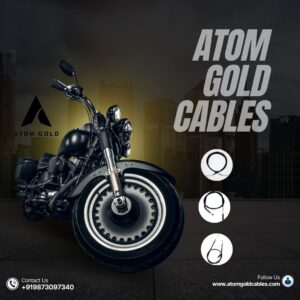As vehicles become increasingly sophisticated, the reliance on electrical systems and their components grows. Among these, automotive cables play a critical role, serving as the veins of electrical connectivity throughout vehicles. However, like all materials, automotive cables experience ageing, which can significantly impact their performance and reliability. This article explores the various factors contributing to cable ageing, the effects it has on performance, and strategies for mitigation.

Understanding Cable Ageing
Cable ageing refers to the degradation of cable materials over time due to environmental factors, mechanical stress, and electrical loading. This deterioration can lead to reduced conductivity, increased resistance, and ultimately, cable failure. The ageing process can be accelerated by several factors, including:
- Temperature Variations: Extreme temperatures can cause thermal expansion and contraction in cable materials, leading to cracks or breaks in insulation and conductors.
- Moisture and Corrosion: Exposure to moisture can result in corrosion of metallic components, while inadequate insulation can allow water ingress, leading to short circuits.
- Chemical Exposure: Automotive environments expose cables to various chemicals, such as oil, fuel, and cleaning agents, which can compromise insulation materials.
- Mechanical Stress: Vibration and movement within the vehicle can cause physical damage to cables, especially in high-wear areas.
- UV Exposure: Cables located externally may be subjected to ultraviolet (UV) radiation, which can degrade plastic and rubber materials over time.
Effects of Ageing on Cable Performance
1. Increased Resistance and Heat Generation
As cables age, their electrical resistance typically increases. This rise in resistance leads to higher heat generation during operation, which can further exacerbate the ageing process. Excessive heat can damage surrounding components and may even result in failure if not addressed. Research has shown that even a small increase in resistance can significantly impact overall vehicle efficiency, particularly in electric and hybrid vehicles where energy management is critical.
2. Insulation Breakdown
The insulation of automotive cables is designed to protect against electrical shorts and environmental factors. Over time, ageing can lead to insulation breakdown, resulting in exposed conductors. This exposure can cause short circuits, which may lead to electrical fires or system failures. According to the National Highway Traffic Safety Administration (NHTSA), electrical faults are a leading cause of vehicle fires, underscoring the importance of maintaining cable integrity.
3. Reduced Flexibility and Increased Brittle Behavior
Cable materials, particularly rubber and plastics, tend to lose flexibility as they age. This loss can lead to cracking and breaking, especially in areas where cables must bend or flex. Rigid cables are more prone to damage under mechanical stress, leading to increased failure rates. A study by the Automotive Research Association of India highlighted that maintaining flexibility is essential for ensuring long-term reliability in automotive wiring systems.
4. Performance Degradation in Electronic Systems
Modern vehicles rely heavily on electronic control units (ECUs) that manage various functions, from engine performance to infotainment systems. Ageing cables can lead to poor connectivity, resulting in erratic performance or complete failure of these systems. For instance, a failing sensor due to cable issues can cause the engine control unit to receive incorrect data, potentially leading to performance problems or increased emissions.
5. Shortened Lifespan of Components
The impact of ageing cables is not limited to the cables themselves; it can also affect connected components. For example, if a cable’s insulation degrades and causes a short circuit, it can damage sensitive electronic components or fuses, leading to costly repairs and downtime. This cascading effect highlights the importance of monitoring and maintaining cable integrity throughout the vehicle’s lifecycle.
Mitigation Strategies
To combat the effects of cable ageing and ensure optimal performance, several strategies can be implemented:
1. Regular Inspections and Maintenance
Conducting regular inspections of automotive cables can help identify early signs of ageing, such as cracks, discoloration, or frayed insulation. Maintenance practices should include cleaning connectors, tightening connections, and replacing any damaged cables promptly.
2. Use of Quality Materials
Investing in high-quality cables that meet industry standards can significantly reduce the risk of premature ageing. Cables made from UV-resistant and heat-resistant materials are particularly beneficial in extending the lifespan of automotive wiring systems.
3. Improved Design Practices
Designing vehicles with proper cable management and routing can help minimize mechanical stress and exposure to harsh conditions. Ensuring that cables are adequately secured and protected from vibration can reduce the likelihood of damage.
4. Environmental Control
Where feasible, controlling the environment in which vehicles operate can help mitigate the effects of ageing. For example, ensuring that vehicles are parked in shaded areas can reduce UV exposure, while proper sealing can help keep moisture and contaminants out.
5. Technology Upgrades
As technology advances, upgrading to newer, more resilient cable designs may offer long-term benefits. Innovations in cable manufacturing, such as improved insulation materials and enhanced shielding, can help reduce the impact of ageing.
Conclusion
The impact of cable ageing on automotive performance is a critical consideration for vehicle manufacturers, service providers, and owners alike. By understanding the factors contributing to ageing and implementing effective maintenance strategies, the longevity and reliability of automotive cables can be significantly improved. As the automotive industry continues to evolve, prioritizing cable integrity will be essential to ensure that vehicles remain safe and efficient on the road.
References
- National Highway Traffic Safety Administration (NHTSA) – Vehicle Fire Safety.
- Automotive Research Association of India – Studies on Automotive Wiring Systems.
- SAE International – The Role of Cable Quality in Automotive Applications.
This comprehensive look at cable ageing underscores the importance of vigilance in maintaining automotive cables, contributing to vehicle safety and performance. If you have any further inquiries or need additional resources, feel free to ask!
Find the Atom Gold difference today – where the heritage of the past is merged with the technology of the future, and quality is the standard.
For more information about our products or to place an order, visit our website or contact us at our office in Ghaziabad, UP. Let us help you drive with confidence, powered by the best accelerator cables in the industry.
Visit us at -Shree Radha Nath Automotive Pvt Ltd , Plot No-35, NCR Industrial Park GT Road Sahibabad, Near Raj Bagh Metro Station, Ghaziabad, UP -201005. Mobile- 9873097340, 82870 63431 Ghaziabad, Uttar Pradesh, India 201005
